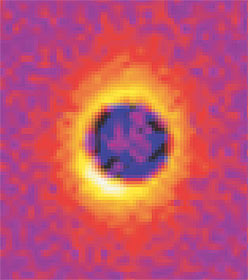Home > Press > Researchers help sort out the carbon nanotube problem
Researchers help sort out the carbon nanotube problem
July 27, 2005
National Institute of Standards and Technology (NIST) and university researchers report a significant step toward sorting out the nanotube “problem” - the challenge of overcoming processing obstacles so that the remarkable properties of the tiny cylindrical structures can be exploited in new polymer composite materials of exceptional strength.
As described in the July 15 issue of Physical Review Letters, (1) their analysis reveals that, during mixing, carbon nanotubes suspended in viscous fluids can be encouraged to sort themselves by length. Achieving uniform sizes of nanotubes is one of several keys to producing affordable, high-quality polymer nanocomposites.
The team found that, under common processing conditions, shorter carbon nanotubes will flow toward the walls of mixing equipment, while the longer tubes tend to congregate in the interior.
Better understanding of factors that promote this self-sorting will point the way to process adjustments and devices that achieve desired arrangements of nanotubes during bulk manufacturing of polymer nanocomposites, says NIST’s Erik Hobbie, leader of the collaboration, which included scientists from the University of Kentucky and Michigan Technical University.
Many times stronger than steel and possessing superlative thermal, optical and electronic properties, nanotubes have been called small-scale wonders, measuring a few nanometers in diameter and ranging greatly in length. Anticipated nanotube-based technologies range from hydrogen storage to transistors to space elevators. Nearest on the horizon are light-weight, high-strength carbon nanotube polymer structural composites.
With lasers, video microscopes and other optical monitoring equipment, the team tracked how nanotubes - both the single-wall and multiwall varieties - behave when suspended, at several different concentrations, in a polymer melt. They analyzed suspensions ranging in viscosity from syrup-like to watery under different mixing conditions.
The results did not suggest a “magic bullet” for getting nanotubes to align uniformly in the same direction - also critical to reliable processing of high-quality nanocomposites. But the finding that, under "modest flow conditions," carbon nanotubes will sort by length could point the way to practical methods for bulk separation of nanotubes according to size.
Further information on nanotube-related research can be found at the Polymers Division Web site at www.nist.gov/polymers.
(1) D. Fry, B. Langhorst, H. Kim, E. Grulke, H. Wang, E.K. Hobbie. Anisotropy of sheared carbon nanotube suspensions. Physical Review Letters, 95, 038304 (July 15, 2005).
Contact:
Mark Bello
mark.bello@nist.gov
301-975-3776
Copyright © National Institute of Standards and Technology
If you have a comment, please Contact us.
Issuers of news releases, not 7th Wave, Inc. or Nanotechnology Now, are solely responsible for the accuracy of the content.
| Related News Press |
Possible Futures
![]() Discovery points path to flash-like memory for storing qubits: Rice find could hasten development of nonvolatile quantum memory April 5th, 2024
Discovery points path to flash-like memory for storing qubits: Rice find could hasten development of nonvolatile quantum memory April 5th, 2024
![]() With VECSELs towards the quantum internet Fraunhofer: IAF achieves record output power with VECSEL for quantum frequency converters April 5th, 2024
With VECSELs towards the quantum internet Fraunhofer: IAF achieves record output power with VECSEL for quantum frequency converters April 5th, 2024
Nanotubes/Buckyballs/Fullerenes/Nanorods/Nanostrings
![]() Tests find no free-standing nanotubes released from tire tread wear September 8th, 2023
Tests find no free-standing nanotubes released from tire tread wear September 8th, 2023
![]() Detection of bacteria and viruses with fluorescent nanotubes July 21st, 2023
Detection of bacteria and viruses with fluorescent nanotubes July 21st, 2023
Discoveries
![]() Chemical reactions can scramble quantum information as well as black holes April 5th, 2024
Chemical reactions can scramble quantum information as well as black holes April 5th, 2024
![]() New micromaterial releases nanoparticles that selectively destroy cancer cells April 5th, 2024
New micromaterial releases nanoparticles that selectively destroy cancer cells April 5th, 2024
![]() Utilizing palladium for addressing contact issues of buried oxide thin film transistors April 5th, 2024
Utilizing palladium for addressing contact issues of buried oxide thin film transistors April 5th, 2024
Announcements
![]() NRL charters Navy’s quantum inertial navigation path to reduce drift April 5th, 2024
NRL charters Navy’s quantum inertial navigation path to reduce drift April 5th, 2024
![]() Discovery points path to flash-like memory for storing qubits: Rice find could hasten development of nonvolatile quantum memory April 5th, 2024
Discovery points path to flash-like memory for storing qubits: Rice find could hasten development of nonvolatile quantum memory April 5th, 2024
|
|
||
|
|
||
| The latest news from around the world, FREE | ||
|
|
||
|
|
||
| Premium Products | ||
|
|
||
|
Only the news you want to read!
Learn More |
||
|
|
||
|
Full-service, expert consulting
Learn More |
||
|
|
||









